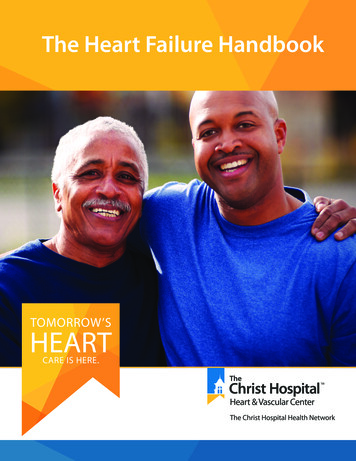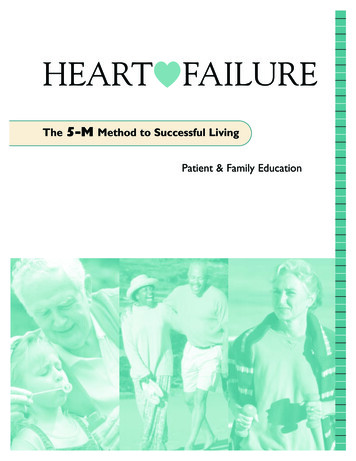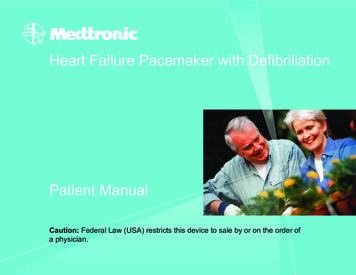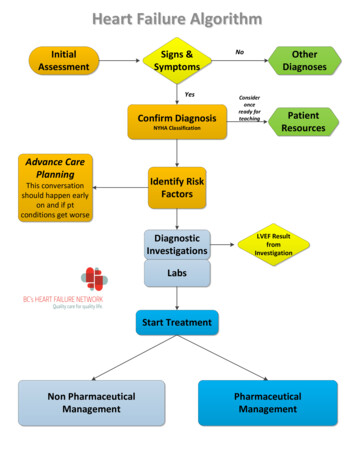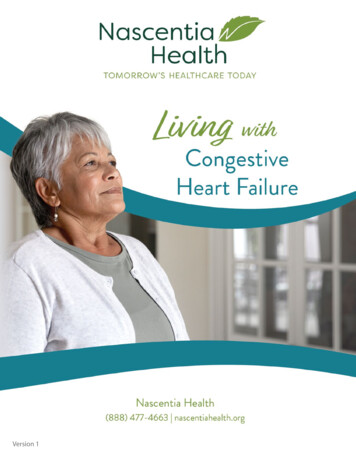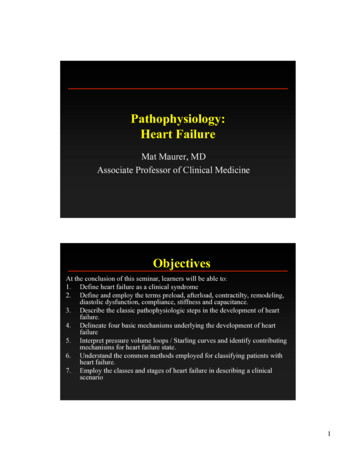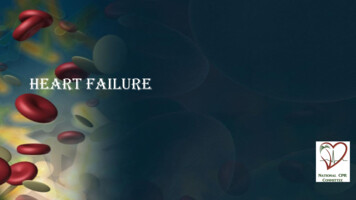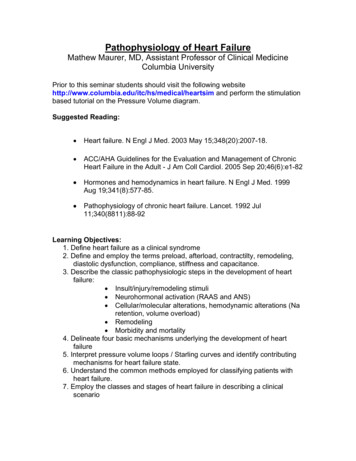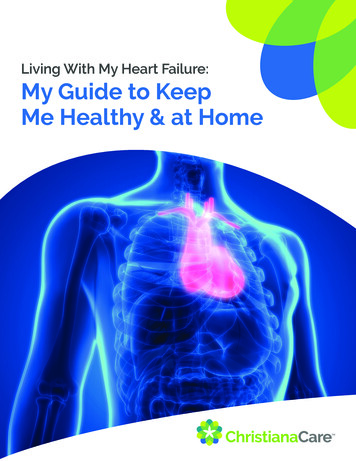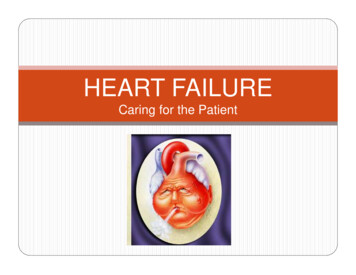
Transcription
HEART FAILURECaring for the Patient
Objectives Describe the normal anatomy of the heart and thephysiology of normal heart function. Understand the pathophysiology of heart failureand the causes and symptoms. Explain the diagnosis and treatment options forindividuals with congestive heart failure. Identify the importance of patient education in aheart failure patient.
Function of the HeartThe heart beats approximately 100,000 times a day every dayof our lives. That means it beats (and pumps) each of the 365 daysper year. With an average life span in the United States of over70 years, that is an incredible total amount of activity! When all isworking well, you don’t even have to think about your heart. Youdon’t have to tell it to beat or explain how fast or how slow to do so.
Cardiac Anatomy and PhysiologyWhen you have a sudden need forincreased oxygenation such asduring exercise, or perhaps stress;the heart pumps at a faster rate.When you are at rest, it will return toyour normal resting rate.The human body and itscompensatory mechanismsconstantly adjust to maintainhomeostasis. Homeostasis is ourbody’s attempt to maintain a state ofequilibrium or constancy in ourinternal environment.
Heart Failure According to the American Heart Association,about 5.7 million Americans are living with heartfailure today. In 2009, there were more than 3 million physicianoffice visits for HF and 668,000 visits to theemergency department (ED). HF is responsiblefor more than 1 million hospital admissions. It is a serious illness that can affect how long aperson lives. You may have heard that somepeople may die sooner because of heart failure.But with proper medications, the correctdosages, and careful management, a HF patientmay live longer and feel better.
What is Heart Failure?Heart failure is a condition that develops when the heart’s musclebecomes weakened, thickened or stiff. These conditions causethe heart to loose its ability to pump enough blood to supply thebody’s needs. It is chronic. It can be treated and managed but not cured. YOU CAN LIVE WITH HEART FAILURE.
How does Heart FailureAffect the Body? Blood Circulation is poor due to the weakened heart muscle. Congestion or fluid can build up in the lung, abdomen, or legs. Is characterized by the myocardium’s inability to pump enoughblood to meet the body’s metabolic demands.
Risk factors for Heart Failure Uncontrolled High Blood Pressure Cardiomyopathy History of AMI Obesity Smoker High Cholesterol Damage to heart valves Diabetes Advanced Age
Classes of Heart FailureDoctors usually classify patients' heart failure according to the severityof their symptoms. The table below describes the most commonlyused classification system, the New York Heart Association (NYHA)Functional Classification. It places patients in one of four categoriesbased on how much they are limited during physical activity.
Systolic Dysfunction Systolic Dysfunction develops because the heart cannot contractnormally. The ventricle contracts poorly and does not empty fully. Thisresults in increased diastolic volume and pressure and eventually theejection fraction falls. Systolic function is common in heart failure thatresults from a myocardial infarction (heart attack). It affects primarilythe left or right ventricle. Left ventricular failure (LV) will often lead toright ventricular (RV) failure as well. Right Ventricular Failure results in increased fluid retention in thetissues, particularly those dependent tissues (such as feet and ankles),as well as in abdominal area. This is the peripheral edema that you seein heart failure.
Diastolic Dysfunction Diastolic Dysfunction develops because the heart’s wallbecomes stiff and may thicken, which interferes with the abilityof the heart to fill with blood. Ventricular filling is impaired. Thecontractility and ejection fraction are good, but the reducedfilling in the left ventricle can produce a lower cardiac outputand systemic symptoms. Elevated pressures in the left atrium can produce pulmonarycongestion, which is seen in the form of pulmonary edemaand increased respiratory distress symptoms. Pulmonaryedema results from left ventricular failure.
Causes and Symptoms ofHeart Failure Symptoms of heart failure may begin suddenly (acute failure)especially if the cause is due to a heart attack. In many people,symptoms develop gradually, and may develop over days tomonths. The disorder may stabilize for periods of time but canoften progress slowly and insidiously (chronic failure). Right and Left sided heart failure produce different symptoms,but sometimes both sides may be involved. When this occursyou may see some symptoms from both, although one side willusually predominate.
Symptoms of Right Sided HFThe symptoms of right sided HF include: Shortness of breath - dyspnea on exertion (DOE) Swelling of feet and ankles Urinating more frequently during nighttime Pronounced neck veins - neck vein distention Palpitations - the sensation of feeling the heartbeat Irregular and rapid heartbeat Fatigue and lethargy Weakness Fainting
Jugular Vein Distention Jugular Vein Distention or JVD, is a sign ofHeart Failure. Assessing JVD can be done by assessingthe internal jugular pulsations that exceed 2finger lengths above the clavicle, with thehead of the bed at 30 degrees.
Symptoms of Left Sided HF Shortness of breath - dyspnea on exertion (DOE). Difficulty with breathing when lying down. Palpitations - the sensation of “feeling” the heartbeat. Irregular or rapid pulse. Cough (Often the cough produces a “frothy” or bloodtinged mucus). Fatigue and weakness (can also result in fainting). Weight gain (resulting from the fluid retention). Oliguria (scanty or decreased urine production).
FACES of Heart FailureSigns and SymptomsFatigue (Tired)Edema(Swelling)ActivitiesLimitedShortnessof BreathCough(Congestion)
What Kinds of Tests Could BeOrdered for a Heart Failure Patient?Chemistry (proBNP, BUN, creatinine) Echocardiogram, Stress TestThe gold standard for assessing ejection fraction in the heart failurepatient is an Echocardiogram Ejection Fraction is the percent of the total ventricular volume pumped witheach contraction; more than 55% is normal; less than 40% is acharacteristic of HF; less than 25% indicates that a patient may be acandidate for heart transplant In diastolic heart failure the EF can be around 50% In systolic heart failure it is usually 40%
Indications for Heart Failure In the chart, you would expect to find a diagnosis of heart failure on aconsult form, a physician order sheet, and/ or progress notes. Examples of heart failure diagnosis progress notes are:o BNP of greater than 500.o Chest X-ray stating congestive heart failure.o Clinically short of breath at rest or a questionable Echocardiogram with anEF of less than 40%. Some of the first signs and symptoms of heart failure is if a patient hada weight gain of more than 3lbs in one day or 5lbs in one week.
Why Are Daily Weights So Important? One of the first signs of heart failure is weightgain. It can be sudden or slow and progressive.The weight gain is due to an accumulation offluid in the abdomen, feet, ankles and legs. Fluid can also back up in the lungs which is whypatients get shortness of breath. Monitoring daily weights is important becauseincreased weight gain in a heart failure patientis cause for concern. Teaching the patient to weigh themselves everymorning after emptying their bladder and to callthe physician if they gain more than 3lbs in aday is essential.
Fluid Restriction and Diet in the Hospital If patient is NPO (Nothing by Mouth), do not give patient water or ice.Sometimes these patients, even if not NPO; can not have waterpitchers or ice in their rooms.No added salt or extra fluid should be given to these patients.Sodium intake in the heart failure patient is usually limited to 2grams daily unless otherwise indicated.Fluid intake is limited to 2000 ml or less.Diet and Fluid intake should be recorded daily.
Activity Should progress astolerated withoutshortness of breath. Activity should befollowed according tothe physician’s orders.
Medication Therapy ACE Inhibitors - can slow the progression of the disease by dilating orwidening blood vessels, decreasing how hard the heart has to work. Maycause excessive coughing. Must monitor potassium closely. Angiotensin II Receptor Blockers - causes muscles surrounding bloodvessels to contract, thereby narrowing blood vessels. Beta Blockers - can slow the progression of the disease by blocking therelease of harmful substances that can damage the heart. These drugspromote “remodeling” of the heart to return to its normal shape. Digoxin - helps strengthen the heart muscle. It is used for specific patients. Diuretics - Helps control symptoms by decreasing the fluid retention andswelling. Best for use in patients with edema. Aldosterone Antagonists - are also weak water pills. These medicationsare used to keep the heart from getting weaker.
Ace Inhibitors ACE inhibitors used in heart failure reduce the blood levels ofangiotensin II and aldosterone. In doing this, they cause the arteriesand veins to dilate and help the kidneys to excrete excess water. There are some side effects to watch for. ACE inhibitors can causemoderate reversible renal insufficiency so monitoring of creatininelevels is helpful, and slower increases in dosage or reduction indiuretic dosage may be needed. Potassium retention may occur,especially if the patient is on potassium supplement. Cough occursin some patients, occasional rash, azotemia, hypotension, andalopecia also are effects that might be seen. Drugs such ascaptopril, benazepril, and lisinopril are examples of ACE inhibitors.
Angiotensin II Receptor Blockers(ARBS)These drugs have effects that are similar to ACE inhibitors but are lesslikely to cause cough and angioedema. They too can cause a reversiblerenal dysfunction. Candesartan, Losartan, Valsartan, and Eprosartan areexamples of this classification.
Beta Blockers These drugs are especially useful in diastolic dysfunctionbecause they reduce the heart rate, prolong the diastolicfilling time, and may improve ventricular relaxation. Twobeta- blockers that are specifically approved for heart failureinclude Cardevilol and long acting Metropolol. Beta-blockersinhibit the activation of the sympathetic nervous system,blocking excessive stimulation of the heart. It should be noted that because these drugs slow the heartrate and reduce the force of the cardiac contractions, theymight initially seem to worsen the symptoms. However theywill produce long-term improvement in heart function andsurvival through blocking the norepinephrine action.
Digoxin Digoxin is a commonly prescribed form of digitalis.It is one of the oldest medications used in thetreatment for heart failure. It increases the force of the contraction and slows aheart rate that is too fast. It is sometimes used withdiuretics and an ACE inhibitor to control symptoms.
Diuretics Diuretics are frequently prescribed for patients with symptoms ofsystolic dysfunction. The dosage is usually adjusted to the lowestdose that will stabilize the patient’s weight and relieve thesymptoms. Diuretics help the kidneys to eliminate salt and waterby increasing the formation of urine and thus decreasing the fluidvolume throughout the body. Commonly used drugs include furosemide (Lasix) andbumetanide (Bumex). When given orally or through IV, they canproduce results within hours or days, improve the cardiacfunction, and enhance the patient’s physical activity tolerance.
Nitrates/Vasodilators Nitrates alone can sometimes relieve heart failuresymptoms. Nitrates are helpful in patients who haveheart failure as well as angina. Vasodilators are not used as often as ACE inhibitors,which are more effective. But they may be used inpeople who don’t respond to ACE inhibitors or cannottake them. Vasodilators such as Hydralazine orIsosorbide Dinitrate are included in this classification.
Potassium ReplacementBecause diuretics causes potassium loss in the urine, there may be apotassium supplement prescribed as well. In severe heart failure adrug such as spironolactone, which is a potassium sparing diuretic;may be used as well. Taking diuretics can result in increasedurination, so advise your patients to take the medication at the sametime daily when they will have ready access to bathroom facilities.
The Joint CommissionRequirements Smoking Cessation education must be documented Assessment of LV Systolic Function: Echo Done? Written Discharge Instructions given and reviewed for all of thefollowing:o Diet/Fluid Instructionso What to do if symptoms worseno Weight monitoring instructionso When to follow up with MD after dischargeo Activity levelThe names of all discharge medications (VERY IMPORTANT)
The Joint CommissionRequirements (2) ACEI/ARB prescribed at discharge for left ventricular systolicdysfunction, i.e. EF 40% OR: documented contraindication:o ACEI allergy, ARB allergy, cougho Moderate or severe aortic stenosiso Renal insufficiency, Hypotension MD must document “No ACEI/or ARB due to .”RN may write as telephone order
Care for the Patientand Education Start and follow admitting orders. On admission give patient the Learning toLive with Heart Failure Booklet(English/Spanish) and go over the bookletwith them. Make sure the patient is weighed onadmission and then daily by 6am;preferably standing weights. Make sure you are doing strict I&Os andfollowing fluid restrictions and NPO orders,if indicated.
Patient Education Educating patients on the prevention of heart failure will helpincrease both the length and quality of their lives. Explaining the diagnosis process and the importance of drugtherapies used to prevent and to treat congestive heartfailure is part of this process. This education should comefrom each member of the interdisciplinary team.
Patient Education in PreventionWhile Admitted to the HospitalWhile your patient is in the hospital, education about preventing a heartfailure exacerbation in the future is key: Weigh yourself Daily at the same time each day. Limit your salt intake and restrict excessive fluids. Take frequent rest breaks for tasks that require physical activity. If youbegin to experience difficulty in breathing and fatigue, stop and take a rest. Take medications as instructed by your physician. Smoking can damage blood vessels, and so it should beavoided. Stopping smoking can help lessen the risk ofcoronary artery disease as well as stroke.
Dietary Modifications Dietary modifications may be aimed at weight loss; however theremay also be a need to restrict the sodium intake as well. Saltsubstitutes and spices may help to provide flavoring in lieu of usinghigher amounts of salt. Sodium can be restricted in cooking as well. It is importance to read the labels on prepackaged foods. Thesefoods can contain significant amounts of sodium that you may not beaware of. For example, diet sodas may have fewer calories thatregular soft drinks, but they still contain sodium. Canned goods andfrozen foods can often contain sodium that must be considered whensodium restriction is an issue.
Daily Weights at HomeWeigh yourself daily, if possible. Weigh yourself at approximatelythe same time each day and wear similar clothing. Use the samescale each time you weigh. Typically you can weigh after arising,urinating, and before eating breakfast. Record your weight so that itwill be easier to spot any trends. If there is an increase of more that3 pounds per day, notify your physician as it can be an earlyindication of the development of heart failure.
Medication Education for Home Make every effort to adhere to your medication regime. Failure to doso may result in a worsening of your condition. Also, make sure allmedication is renewed regularly and available at all times. If you are taking a digitalis medication such as Digoxin, watch for anabnormally slow heartbeat. Know when you should contact your physician and when emergencymedical services should be contacted. Learn the potential signs andsymptoms of heart failure from your physician or healthcare provider.Discuss these signs and symptoms with your healthcare surrogate,family members, friends, and neighbors.
Discharge Continue HF teaching. Fluid Restriction Order. Daily Weights: Call physician if weight gain lbs. in days. Given patient discharge instructions from Micromedex: Heart Failure. ACEI or ARB ordered, not indicated or contraindicated and EF. If contraindicated state reason. Also, Care Coordination or Social Worker to arrange follow up care toCardiologist or PCP.
Discharge (2) A patient should call his/her physician if any of the followingsymptoms develop:o Increased shortness of breath for unknown reasons.o Sudden weight gain of 2-3 lbs in one day.o Frequent cough, especially when lying down.
Follow-UpAppointments Discharge instructions should include the name and phonenumber of the primary care physician, and when to follow-up. Follow-up appointments should be scheduled prior to dischargeby the care coordinator or social worker. Recent research shows that 58% of patients never made afollow-up appointment and were readmitted within 30 days.
Medication Reconciliation The physician and RN should be addressing all home medications, allmedications on the current MAR and any new prescriptions that areincluded on the Discharge Medication Form. ACEI/ARB prescribed at discharge for left ventricular systolicdysfunction, i.e. EF 40% OR: documented contraindication:o ACEI allergy, ARB allergy, cough.o Moderate or severe aortic stenosis.o Renal insufficiency, Hypotension. OR MD must document “No ACEI/or ARB due to .”RN may write as telephone order.
Things That AreImportant To Us . Core Measureso Smoking Cessationo Echo/Ejection Fractiono Teachingo Medications Patient EducationDaily Weights (preventing swelling)o Medications (Oxygen therapy, etc.)o Dieto Exercise/ Activityo Preventing Infectionso Talking with your PCP
References Bosson, O., RGN. (2003). The role of the heart failure nurse specialist. Retrieved onJuly 14, 2007 at: priory.com/cmol/heartfail.htm Grossman, F., M.D. & Brown, D., M.D. (2006). Congestive heart failure and pulmonaryedema. Retrieved on July 14, 2007 at: emedicine.com/EMERG/topic108.htm Hunt SA, Abraham WT, Chin MH, et al. 2009 focused update incorporated into theACC/AHA 2005 Guidelines for the Diagnosis and Management of Heart Failure inAdults: a report of the American College of Cardiology Foundation/American HeartAssociation Task Force on Practice Guidelines: developed in collaboration with theInternational Society for Heart and Lung Transplantation. Circulation 2009; 119:e391.’ Circulation, 2009 Focused Update: ACCF/AHA Guidelines for the Diagnosis andManagement of Heart Failure in Adults
Congratulations!You have successfully completed this portion of this course.Take the post test and score at least 80% to successfully completethe test. After passing the test, please provide us with your valuablefeedback in the brief evaluation so that we may continue to improveour courses. The evaluation is not required for successful completionof this course.Thank you!HR Learning Management
Indications for Heart Failure In the chart, you would expect to find a diagnosis of heart failure on a consult form, a physician order sheet, and/ or progress notes. Examples of heart failure diagnosis progress notes are: o BNP of greater than 500. o Chest X-ray stating congestive heart failure.
